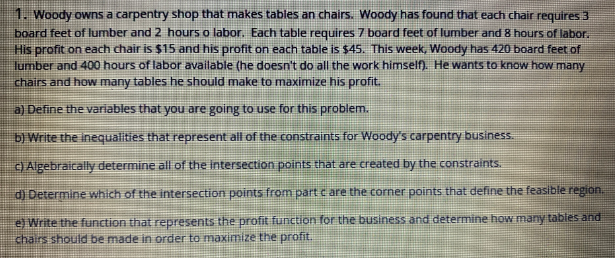1. Woody owns a carpentry shop that makes tabies an chairs. Woody has found that each chair requires 3 board feet of lumber and 2 hours o labor. Each table requires 7 board feet of lumber and 8 hours of labor. His profit on each chair is $15 and his profit on each table is $45. This week, Woody has 420 board feet of lumber and 400 hours of labor available (he doesn't do all the work himself). He wants to know how many chairs and how many tables he should make to maximize his profit. a) Define the variables that you are going to use for this problem. b) Write the inequalities that represent all of the constraints for Woody's carpentry business. O Algebraically determine al of the intersection points that are created by the constraints. d) Determine which of the intersection points from part c are the corner points that define the feasible region. eWrite the function that represents the profit function for the business and determine how many tables and chairs should be made in order to maximize the profit.
1. Woody owns a carpentry shop that makes tabies an chairs. Woody has found that each chair requires 3 board feet of lumber and 2 hours o labor. Each table requires 7 board feet of lumber and 8 hours of labor. His profit on each chair is $15 and his profit on each table is $45. This week, Woody has 420 board feet of lumber and 400 hours of labor available (he doesn't do all the work himself). He wants to know how many chairs and how many tables he should make to maximize his profit. a) Define the variables that you are going to use for this problem. b) Write the inequalities that represent all of the constraints for Woody's carpentry business. O Algebraically determine al of the intersection points that are created by the constraints. d) Determine which of the intersection points from part c are the corner points that define the feasible region. eWrite the function that represents the profit function for the business and determine how many tables and chairs should be made in order to maximize the profit.
Linear Algebra: A Modern Introduction
4th Edition
ISBN:9781285463247
Author:David Poole
Publisher:David Poole
Chapter2: Systems Of Linear Equations
Section2.4: Applications
Problem 28EQ
Related questions
Question

Transcribed Image Text:1. Woody owns a carpentry shop that makes tabies an chairs. Woody has found that each chair requires 3
board feet of lumber and 2 hours o labor. Each table requires 7 board feet of lumber and 8 hours of labor.
His profit on each chair is $15 and his profit on each table is $45. This week, Woody has 420 board feet of
lumber and 400 hours of labor available (he doesn't do all the work himself). He wants to know how many
chairs and how many tables he should make to maximize his profit.
a) Define the variables that you are going to use for this problem.
b) Write the inequalities that represent all of the constraints for Woody's carpentry business.
O Algebraically determine al of the intersection points that are created by the constraints.
d) Determine which of the intersection points from part c are the corner points that define the feasible region.
eWrite the function that represents the profit function for the business and determine how many tables and
chairs should be made in order to maximize the profit.
Expert Solution
This question has been solved!
Explore an expertly crafted, step-by-step solution for a thorough understanding of key concepts.
This is a popular solution!
Trending now
This is a popular solution!
Step by step
Solved in 2 steps

Recommended textbooks for you

Linear Algebra: A Modern Introduction
Algebra
ISBN:
9781285463247
Author:
David Poole
Publisher:
Cengage Learning

Algebra for College Students
Algebra
ISBN:
9781285195780
Author:
Jerome E. Kaufmann, Karen L. Schwitters
Publisher:
Cengage Learning

Algebra and Trigonometry (MindTap Course List)
Algebra
ISBN:
9781305071742
Author:
James Stewart, Lothar Redlin, Saleem Watson
Publisher:
Cengage Learning

Linear Algebra: A Modern Introduction
Algebra
ISBN:
9781285463247
Author:
David Poole
Publisher:
Cengage Learning

Algebra for College Students
Algebra
ISBN:
9781285195780
Author:
Jerome E. Kaufmann, Karen L. Schwitters
Publisher:
Cengage Learning

Algebra and Trigonometry (MindTap Course List)
Algebra
ISBN:
9781305071742
Author:
James Stewart, Lothar Redlin, Saleem Watson
Publisher:
Cengage Learning

College Algebra
Algebra
ISBN:
9781305115545
Author:
James Stewart, Lothar Redlin, Saleem Watson
Publisher:
Cengage Learning